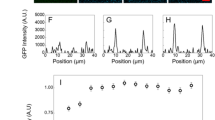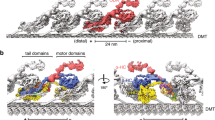Abstract
Directed intracellular particle movement is a fundamental process characteristic of all cells. During fast axonal transport, membranous organelles move at rapid rates, from 1 to 5 µm s−1, in either the orthograde or retrograde direction along the neurone and can traverse distances as long as 1 m (for reviews, see refs 1–3). Recent studies indicate that this extreme example of intracellular motility can occur along single microtubules4, but the molecules generating the motile force have not been identified or localized. It is not known whether the force-transducing ‘motor’ is associated with the moving particle or with the microtubule lattice. To distinguish between these hypotheses and to characterize the membrane–cytoskeletal interactions that occur during vesicle translocations, we have developed a reconstituted model for microtubule-based motility. We isolated axoplasmic vesicles from the giant axon of the squid Loligo pealei as described previously5. The vesicles (35–475 nm in diameter) were then added to axonemes of Arbacia punctulata spermatozoa that served as a source of microtubules. Axonemes were used because the tubulin subunit lattice of the A-subfibre of a given outer doublet is the same as the subunit lattice of neuronal microtubules along which motility occurs6,7. Moreover, all the microtubules of a single axoneme show the same structural polarity8–10, indicating that the axoneme represents an oriented microtubule substrate. Here we demonstrate that vesicle motility is ATP-dependent, that it is not mediated by the flagellar force-transducing molecule dynein and that the direction of movement is not specified by microtubule polarity.
This is a preview of subscription content, access via your institution
Access options
Subscribe to this journal
Receive 51 print issues and online access
$199.00 per year
only $3.90 per issue
Buy this article
- Purchase on Springer Link
- Instant access to full article PDF
Prices may be subject to local taxes which are calculated during checkout
Similar content being viewed by others
References
Brady, S. T. & Lasek, R. J. Meth. Cell Biol. 25, 365–398 (1982).
Grafstein, B. & Forman, D. S. Physiol. Rev. 60, 1167–1283 (1980).
Weiss, D. G. (ed.) Axoplasmic Transport (Springer, New York, 1982).
Schnapp, B. J., Vale, R. D., Sheetz, M. P. & Reese, T. S. Cell 40, 455–462 (1985).
Gilbert, S. P. & Sloboda, R. D. J. Cell Biol. 99, 445–452 (1984).
Amos, L. A. & Klug, A. J. Cell Sci. 14, 523–559 (1974).
Erickson, H. P. J. Cell Biol. 60, 153–167 (1974).
Allen, C. & Borisy, G. G. J. molec. Biol. 90, 381–402 (1974).
Binder, L. I., Dentler, W. L. & Rosenbaum, J. L. Proc. natn. Acad. Sci. U.S.A. 72, 1122–1126 (1975).
Haimo, L. T., Telzer, B. R. & Rosenbaum, J. L. Proc. natn. Acad. Sci. U.S.A. 76, 5759–5763 (1979).
Gibbons, I. R. Archs Biol., Liege 76, 317–352 (1965).
Warner, F. D. & Satir, P. J. Cell Biol. 63, 35–63 (1974).
Gibbons, B. H. & Gibbons, I. R. J. Cell Sci. 13, 337–357 (1973).
Summers, K. E. & Gibbons, I. R. Proc. natn. Acad. Sci. U.S.A. 68, 3092–3096 (1971).
Summers, K. E. & Gibbons, I. R. J. Cell Biol. 58, 618–629 (1973).
Bloodgood, R. A. J. Cell Biol. 75, 983–989 (1977).
Bloodgood, R. A., Leffler, E. M. & Bojczuk, A. T. J. Cell Biol. 82, 664–674 (1979).
Allen, R. D. & Allen, N. S. J. Microsc. 129, 3–17 (1983).
Laemmli, U. K. Nature 227, 680–685 (1970).
Reynolds, E. S. J. Cell Biol. 17, 208–211 (1963).
Author information
Authors and Affiliations
Rights and permissions
About this article
Cite this article
Gilbert, S., Allen, R. & Sloboda, R. Translocation of vesicles from squid axoplasm on flagellar microtubules. Nature 315, 245–248 (1985). https://doi.org/10.1038/315245a0
Received:
Accepted:
Published:
Issue Date:
DOI: https://doi.org/10.1038/315245a0
This article is cited by
-
Tracking kinesin-driven movements with nanometre-scale precision
Nature (1988)
-
Structure and function of the prehensile tentilla of Euplokamis (Ctenophora, Cydippida)
Zoomorphology (1988)
-
Kinesin: Its properties and possible functions
Protoplasma (1988)
-
Attachment of transported vesicles to microtubules in axoplasm is facilitated by AMP-PNP
Nature (1985)
-
Identification of kinesin in sea urchin eggs, and evidence for its localization in the mitotic spindle
Nature (1985)
Comments
By submitting a comment you agree to abide by our Terms and Community Guidelines. If you find something abusive or that does not comply with our terms or guidelines please flag it as inappropriate.



